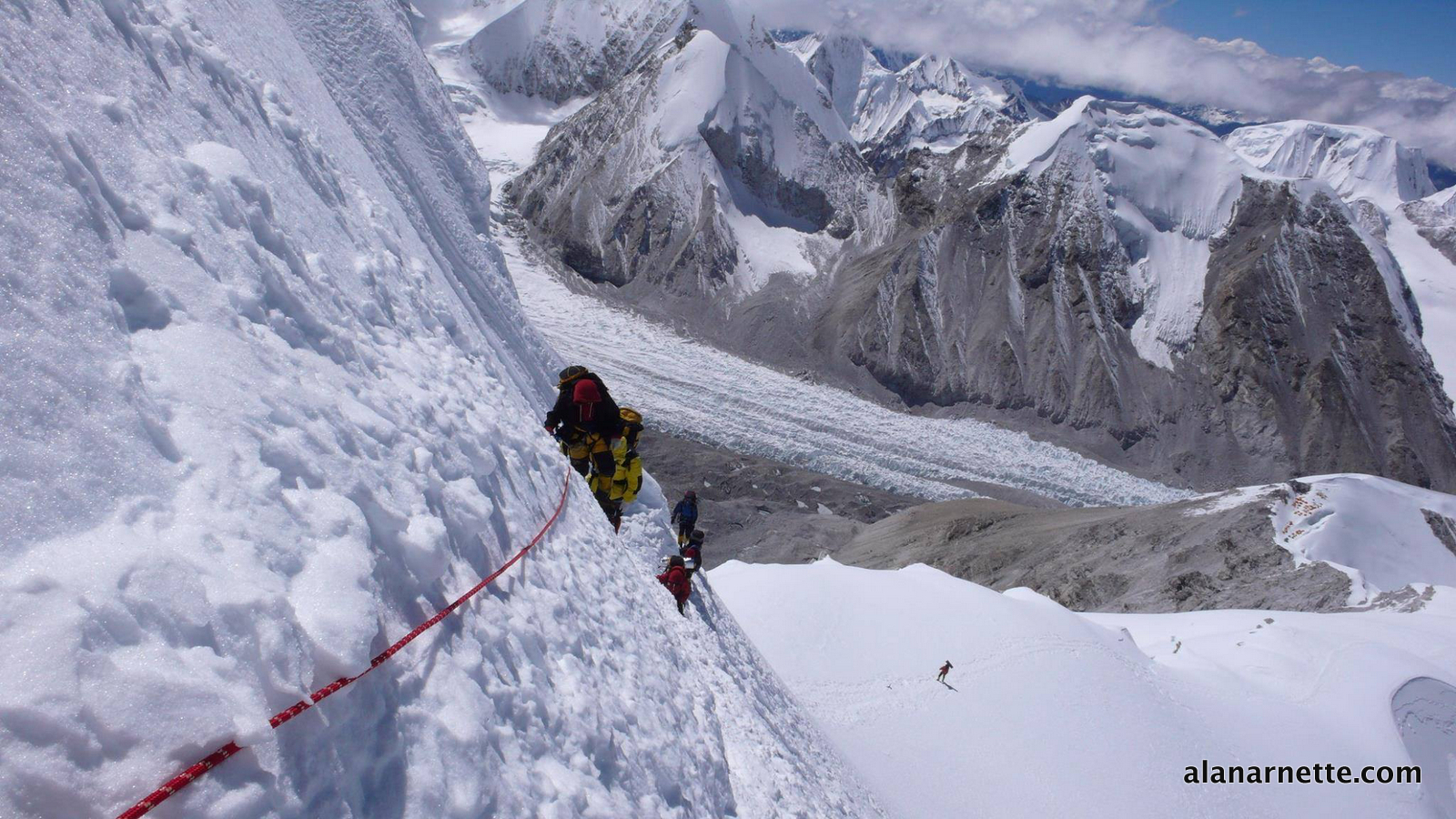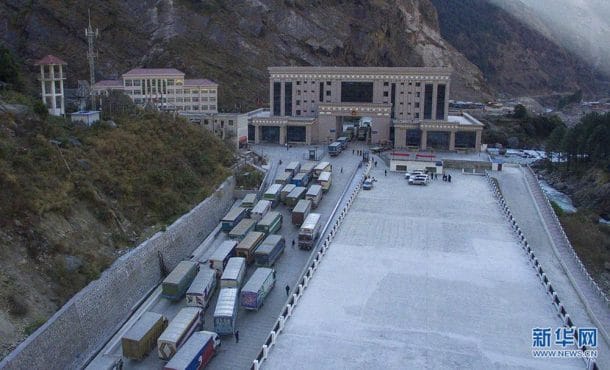Well, the K2 climbers pulled it off. Congratulations to the 150++ who summited and especially to the Sherpas who fixed the lines to the summit. The weather cooperated, and there were limited problems, albeit with one death and one K2 climber is currently missing. We are approaching 200 K2 summits.
Big Picture Summits Continue, Missing K2 Climber
Several media outlets report that Canadian Richard Cartier, 61, is missing while descending from a rotation to lower Camp 4. He was last seen between C2 and C1 by teammates. A search is underway. They had mentioned using the Cesen route but were on the Abruzzi when he disappeared.
At least 10 more K2 summits brought the total ever closer to 200. Summit Karakorum reports that Abid Asad Sadpara, the nephew of the late Ali Sadpara, who died on K2 last year, made the top with no O’s. Also, Paul Etherdge, Peter ? and Muhammad Hussain Pakista. Makalu Extreme team reports summits from French alpinists Pascal Claude France and Christophe Jean France with Pasang Lama and Pasang Dorjee Sherpa.
This has been a great year across all the 8000ers for female climbers. Adding to the K2 list is Spanish (Andalusian) climber Lina Quesada. She is joined by these female summiteers this season: Norweigan Kristin Harila, Andorian Stefi Troguet, Taiwanese Grace Tseng, Chinese He Jing, Pakistanis Naila Kiani, and Samina Baig, plus Omani Nadhira al Harthy, Iranian Afsaneh Hesamifard and UAE’s Saeed Almemari. Also, several American women, including Jennifer Drummond and some who have asked not to use their names.
There have been a few more summits, but these teams reported summits with 88 Sherpa or Pakastani support for 54 clients:
- 8K Expeditions (Nepal) – 11
- Elite Expeditions (Nepal) – 33
- Furtenbach Adventures (Austria) – 14
- Madison Mountaineering (US) – 15
- Mingma G’s Imagine Nepal (Nepal) – 23
- Pioneer Adventure (Nepal) – 10
- Seven Summits Treks (Nepal) -11
- Summit Karakorum (Nepal) – 4
- Karakorum Expeditions (Pakistan) – 6+
The first summit of K2 was in 1954. There were few or no summits for years until the dam broke in 1986 with 26. However, K2’s history is sporadic at best for double-digit summit years. There have been 32 years since 1954 with no summits compared to only nine for Everest since 1953. There have been 15 double-digit summit years on K2, with 2018 holding the previous record with 62 summits.
What’s Changed?
I wrote that K2 would never become Everest in a 2016 blog. I was wrong. I primarily noted six areas that would keep K2 from being promoted to the mass market. Let’s review them as we see record summits on K2 in 2022.
K2 is a technical high-altitude climb, limiting the attraction.
In the Spring of 2022, the massive success across the Nepal 8000ers proved that when clients receive strong support, they can summit 8000-meter peaks, including several in one season.
A new client climbing model had been developed primarily with Seven Summits Treks, SST, leading the way. The formula used a high ratio of Sherpas to clients, a high oxygen flow sometimes starting at lower camps, and most importantly, letting the Sherpas fix the ropes to the summit while also establishing and stocking the higher camps. While the Sherpas worked hard high on the mountain, the clients stayed at base camp or completed a minimum number of rotations to conserve energy.
With SST’s success mainly on Everest but also on Manaslu or a few other 8000ers, other Nepali guide operations followed, including 8K Expeditions, Imagine Nepal, Elite Expeditions, Pioneer Adventures, and more. Meanwhile, the western operators evolved their offerings with a similar oxygen strategy, strong Sherpa support, and a level of base camp luxury that we’ve never seen.
So when it came time to consider climbing K2, many potential clients felt they only needed to focus on climbing, and most came prepared to manage the technical complexities K2 presents, knowing they would have excellent support. I want to note that this year we saw many clients summit with minimal Sherpa support and some without supplemental oxygen, so my description does not apply to all K2 climbers but does help explain the high number of permits issued, 475.
The local mountaineering support pales in comparison to Everest.
The climbing support community in Pakistan is minimal. While there are hundreds of strong men to ferry gear from Askole to base camp, skilled high-altitude support in Pakistan is limited. The Nepali companies solved this by bringing over their highly trained, loyal Sherpas to recreate the same environment they developed in Nepal. Perhaps one day, Pakistan will have a similar level of support as in the Khumbu, but it will take years.
K2’s weather is worse than Everest, thus reducing summit success.
Weather is variable, with some great years then disastrous ones. This Spring in Nepal, for all of May, it was a virtual weather window with low winds and light snow (of course, there were exceptions). Similarly, on K2, the season started well, allowing many climbers to do their minimum acclimatization rotations. Then, it turned ugly for a week before quietening enough to allow a massive number of clients to summit on July 20/21/22. The climbing conditions could not have been better.
K2’s death rate is much higher than Everest, thus scaring many away.
The K2 death rates are slowly decreasing as the summit rates go up; thus, the scary statistic of one in four climbers dying on K2 has shrunk from 25% to under 16%. While still high, some clients today seem to feel invincible, with the “it will not happen to me” attitude. This belief is encouraged by operators describing their strong Sherpa teams, successful, charismatic leaders, and an overall perspective of invincibility.
Helicopter rescue is rare and expensive, thus increasing the risk of dying.
Pakistan’s Northern Terrorties, including K2, Broad Peak, and the Gasherbrums, are located next to the ‘disputed zone’ with India centered around Kashmir. While there are skirmishes from time to time, it’s overall peaceful. However, the Pakistani military controls the area and flies all helicopter missions as if they were at war; thus, every rescue request requires two helicopters. The cost can run from USD$20-30,000 each time. In Nepal, helicopters are privatized, costing a few thousand to fly someone out of Base Camp.
This year, for the first time I’m aware of, helicopters regularly flew clients to and from base camp charging $20,000 per flight. This high cost suggests that many well-funded clients absorbed the price, sometimes split between four people.
The trek to Base Camp is long, complicated, and uncomfortable, discouraging some from trying.
It appears that clients have accepted this as part of the mystery and allure of K2. However, many clients flew over the Baltoro Glacier in choppers this summer. Also, the road is extended beyond Askole, thus reducing the trek by a day. So, overall, if you want to climb K2, the trek has become more achievable, yet still lacking the ‘amenities’ seen throughout Nepal’s trekking regions.
So with all of this, Why is K2 becoming more popular?
In a phrase, I’d say “risk mitigation.” It feels like the climbing community has a short memory when it comes to mountaineering disasters. Thankfully 2022 in on track to be one of the safest. There were three deaths on Everest, one or two (still undetermined) on both K2 and Broad Peak, and one on Gasherbrum II. These are tragic but relatively low compared to the sheer volume of climbers on these peaks.
Forgotten are the devastating years on Everest of 1982, 1988, 1996, 2006, ’12, ’14, ’15, ’19, when ten or more lost their lives. Or on K2 in 1986 and 2008 when disaster struck. Climbers are seduced by epic tales of superhuman feats that they believe can be repeated. Some can; others are dreams to be followed.
Aggressive guides apparently feel the ‘other’ 8000ers than Everest, Lhotse, Manaslu, and Cho Oyu have been tamed by leveraging incredibly strong and intelligent Sherpas and well-thought-out plans. They figured it out on Nepal’s high peaks, so applying the formula to the other 8000ers in Pakistan was just a matter of time.
Another change is with today’s clients who have more time and money; many are younger and female. The demographics for Everest was a male in his mid 40’s with a few other climbs as experience. However, today’s high-altitude climber profile is moving towards a female in her mid-30s with a strong climbing background and a thoughtful approach of partnering with several highly qualified Sherpas. 2022 may have become the year of the female climbers, with many highly qualified women seeking and setting records for themselves or their countries.
Gasherbrum II – More Summits
Denis Urubko got his second 8000er of the summer in clean style. His home team reported in with this post:
On the 23rd of July, the high-altitude mountaineer Denis Urubko did another interesting composition in the Karakorum. Starting at 03:00 from BC, he went alone by the ice-fall, the long glacier, and followed the classical route of Gasherbrum-2 with some stops for breakfast and lunch. Finally, he reached the summit at 18:20 in rows of sunset.No people were on slopes in upper camps, so Denis enjoyed his personal adventure in pure style. Especially that he helped to fix ropes at the beginning on G2; then he took “a break,” during which he made a powerful ascent on Broad-peak on the 19th of July.Denis descended from the top of Gasherbrum-2 directly to BC at 04:00 in the next morning and arrived back after a 25-hours trip, extremely tired but satisfied. Such an adventure looks like a new step for that remote zone. For Urubko, it is the fifth time on G2 (always a different mode) and the 25th ascent on a mount above 8000 m. WELL DONE, DENIS!!
Kobler & Partner checked in with GII summits:
We congratulate Andrea, Elisabeth, Ingrid, Simon, Ramon, Markus and K&P expedition leader Andreas on the summit success on 22.07.! Without our strong Sherpas from Nepal, our high beams from Pakistan and without the excellent organization of Mashabrum Expeditions, this success would not have been possible. The picture shows Ramon at the summit at 8035 m at 4 a.m. on 07/22. The whole team is safely back in the base camp. A detailed report will certainly follow after the summit party.
The Future of 8000ers
I believe that we witnessed a seismic shift in mountaineering in 2022. More 8000ers were summited by more Sherpas than in history. For the first time, Sherpas led the totals for all-time Everest summits. Now I believe they lead on K2. We saw a new generation of climbers, led by women, demonstrate vision and strength. And we saw a new climbing model that some will declare is no longer “climbing.”
In a video interview with Adventure Consultants’ Guy Cotter, he made a comparison to the reaction to sport over trad rock climbing. Sport brought in the use of pre-set anchors absolving the climber from having to bring and place their own protection. A similar outcry occurred when David Braeshears guided Dick Bass and Frank Wells to the top of the highest peak on all seven continents, aka the 7 Summits. Then in the early 1990s, we saw Adventure Consultants Gary Ball and Rob Hall take $65,000 from relatively inexperienced clients to guide them to the summit of Everest.
Today, we see a new climbing model that opens the sport to the mass market. I’m excited to see more people enjoying the thrill and challenge of climbing; however, I’ll maintain my mantra from the last few years of explosive growth:
- The climbers must be self-sufficient, experienced, and demonstrate personal responsibility and integrity.
- The guides must be trained and experienced and keep client safety the top priority.
- And everyone from governments to operators to each person who steps on every mountain must embrace every aspect of Leave No Trace ethics.
Climb On!
Alan
Memories are Everything
The Video Version of this Weekend Update
The Podcast on alanarnette.com
You can listen to #everest2022 podcasts on Spotify, Apple Podcast, Google Podcasts, Pocket Casts, RadioPublic, Anchor, and more. Just search for “alan arnette” on your favorite podcast platform.
Summit Coach
If you dream of climbing mountains but are unsure how to start or reach your next level, from a Colorado 14er to Rainier, Everest, or even K2, we can help. Summit Coach is a consulting service that helps aspiring climbers worldwide achieve their goals through a personalized set of consulting services based on Alan Arnette’s 25 years of high-altitude mountain experience, including summits of Everest, K2, and Manaslu, and 30 years as a business executive.






2 thoughts on “K2 Summer 2022: Weekend Update July 24, 2022 – Summiting Like Never Before”
That is a very positive way of thinking about that and i guess you are right. It is an accomplishment of a group of people. With a lot of help from guides/porters/sherpas these days. Nonetheless still a great achievement.
Or the other hand, i am affraid that the current way of mountaineering will lead to a/more big accident(s). Sooner or later a big avalanche will sweep away lots of people. I see reports of big groups going up Annapurna, notorious for avalanches and unpredictability. This is a disaster waiting to happen.
Weather is much more predictable these days, avalanches (or a chunk of ice coming loose for example in the bottleneck) is not.
Hope we wont see that happen. Good luck to all the climbers
Humans tend to do their greatest things in great numbers. That is most definitely our thing. The individual great accomplishment is definitely a Western Thought thing..Ingrained..In me too. But this is better. It is objectively better. Once we let go of that deep western individual thought. Not easy. Working on it myself.
Comments are closed.